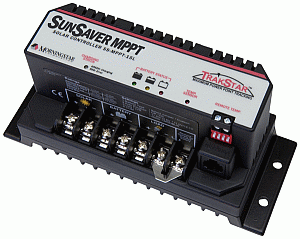Charge Controllers
A charge controller or charge regulator is a combination of a high-efficiency DC/DC
converter and a high-end battery charger.
The power and more specific the voltage generated by solar panels or wind generators
will vary considerable depending on the environmental conditions (solar radiation, windspeed, ...).
The DC/DC converter regulates the voltage generated by a solar panel or wind generator to the
appropriate voltage needed to charge the connected batteries according to the required charging
algorithm. By regulating the voltage, also the power flow from the generators to the batteries
is controlled.
Some simple controllers use shunt- or disconnect transistors to regulate voltage and
current on the battery side. The excessive power generated in the solar modules is simply
dissipated in the shunt transistors. These controllers are simple and cheap but are only
suited for low-power applications.
For a more productive transportation of the - variable - generated power into
the battery system, more efficient charge controllers must be used.
These are based on switch-mode or PWM technologies for power adaptation and are usually
micro-processor controlled. The use of fast switching semiconductor devices allow
for a power efficiency in the range of 95% to 98%.
Most controllers come with a remote control including a display for monitoring the enery
flow into and out of the battery system as well as an estimation of the available battery
capacity.
Charge controller are normally fed from solar panels or a wind generator, but if shore
supply is available, they could also be fed from an appropriate AC/DC converter omitting
the need for a more expensive battery charger. In the same way the engine alternator can be
used to feed directly the charge controller.
|
Notice that in order to work properly, nearly all charge controllers require a battery
connected to the output. They cannot be used as 12-Volt regulator for the output a solar
panel or wind generator without battery connected.
Some controllers have a "LOAD" or "LVD" output, which can be used to connect small loads
to the battery system. The advantage of connecting through the controller is that
the controller will turn off this output if the battery voltage drops below 11.5V.
This will prevent from discharging the battery system too deep. However, this output
should not be used for connecting high-power loads, such as the anchor windlass or
an inverter, because the high surge currents will destroy the controller.
For this purpose, the "LVD" output can drive a heavy-duty relays to disconnect the
high-power loads. |

|
Some manufacturer of charge controllers suited for on-board battery systems:
|
